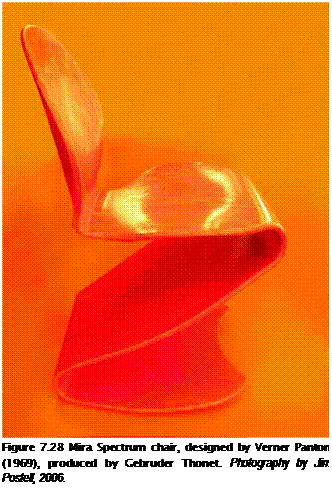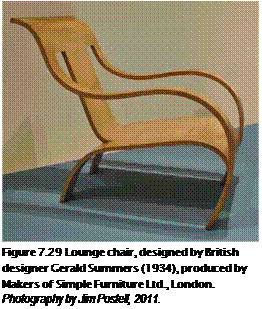Composite boards are built-up boards used for specific applications. They are the material of choice for use as a substrate for large case goods that have an applied veneer. They are occasionally used as a finishing material. Composite boards often have a core with thinner plies of wood or other materials applied to each side of a core. They also include a range of fiberboards, such as oriented strand board (OSB), MDF, Medite II (which is one of many MDF products made without formaldehyde), high-density fiberboard (HDF), wheatboard, and particleboard.
MDF and HDF
MDF is manufactured from softwoods broken down into wood fibers through steam pressure and mixed with wax and resin. The mix is then formed into sheets using high pressure and applied heat. MDF has an exceptionally smooth surface, and because of its nondirectional quality, it can be easily and precisely machined. It is an excellent substrate for wood veneer and high-pressure decorative laminate (HPDL) sheets because it is stable, flat, and smooth faced. MDF is not moisture resistant. There is a waterproof variety called MDX. MDF will resist moisture better than OSB or particleboard, however.
MDF is one of the most dimensionally stable wood-based composite materials available today and is often used as a substrate for wood veneers and plastic laminates. It is available in 49 inch x 97 inch (124 cm x 246 cm) sheets.
High-density fiberboard (HDF), or Masonite, is also known as hardboard. HDF is an engineered fiberboard. It is similar to MDF, but it is denser, stronger, and harder. HDF is manufactured from exploded wood fibers that have been significantly compressed. Tempered HDF is hardboard that has been coated with a film of linseed oil. This process makes tempered HDF more water and moisture resistant, more impact resistant, denser, and harder than MDF. HDF is used for drawer bottoms and back panels in contemporary furniture.
Plywood
The origins of plywood extend back to ancient Egypt and China, but modern plywood is a product of the Industrial Revolution. In the early 1900s, aviation research enhanced the production methods and material characteristics of plywood, including its weather resistance. In the 1920s, plywood was used to create radical new forms. By the 1930s and 1940s, architects and designers including Alvar Aalto and Charles and Ray Eames were experimenting with its practicality and beauty in furniture design.
Plywood is a composite board that consists of an odd number of thin plies of wood, which have been peeled off the log, called veneers. These veneers are laminated with glue at right angles in grain direction to each other, thus preventing the plywood from warping or cupping. The assembled and glued veneers are formed into sheet goods, bound under pressure and heat. Standard construction-grade plywood has three plies, whereas furniture and millwork-grade plywood have at least five plies. The alternating core laminations in American plywood are Vs-inch (3 mm) thick and can be made from several species of woods, including poplar, Douglas fir, and pine. Finished plywood is often sold in 4-foot x 8-foot (122 cm by 244 cm) sheets. Baltic birch plywood is made with Vi6-inch (1.5 mm) core laminations made from solid birch and is sold in 5-foot x 5-foot (150 cm x 150 cm) sheets. Bending plywood is typically Vs-inch (0.95 cm) thick and is typically sold in 4-foot x 8-foot (122 cm x 244 cm) sheets to either barrel roll or column roll, depending on the desired direction for the bend. In addition, Vs-inch (3 mm) thick bending plywood is available in 4-foot x 8-foot (122 cm by 244 cm) sheets and can be made to curve with a radius as tight as 2V2 inches (6.3 cm). It is typically manufactured using Philippine mahogany (Luann) and birch, with the veneers laminated perpendicular to one another.
American plywood can be purchased with a variety of wood veneer species and in a spectrum of surface and core qualities ranging from an A grade (high) to a D grade (low) on its face side and the number 1 (high) to 4 (low) describing the quality on its back side. The core of plywood is also rated using a letter system; K is a good-quality core, and lower grades are labeled with the letter L or M. The letter and numeric notations are established by the Hardwood Plywood and Veneer Association (HPVA). Hardwood veneer is graded for quality by the Architectural Woodwork Institute (AWI).
■ Grade A: The veneer is smooth, tight cut, and full length. The grain of the hardwood must run parallel to the plywood. Rotary-cut faces may be whole piece or multipiece with tight edge joints having no sharp color contrasts at the joints. Face grain panels must be book matched. Plain-sliced (flat-cut) faces will be book matched unless otherwise specified.
■ Grade B: The veneer is smooth, tight cut, and full length. Slip – or book-matched veneers are available. Sharp color contrasts at all joints are not permitted. Hardwood veneer faces may contain small burls and occasional pin knots, which may not exceed 6 mm (V4 inch) in total diameter. Unfilled wormholes, rough-cut veneer, knots, and other defects are not permitted.
Baltic birch has better structural qualities and a more attractive edge grain than American plywood, but is generally available only in a B grade surface and only in 5-foot x 5-foot (150 cm x 150 cm) sheets. Despite the limitations of its size, Baltic birch plywood is an excellent choice for cabinet and drawer fabrications but typically is not used as finish plywood.
 Plywood can be bent and molded by machine, creating compound curves, which can better support the human body. The world’s first cantilevered molded plywood chair, the Panton S chair, designed by Verner Panton, was produced in 1966 by A. Sommer for Thonet. It is remarkably light and was a precedent for Panton’s later laminated wood and injected molded and stackable Panton chairs. The laminated-wood Mira Spectrum chair (ca. 1969) is shown in Figure 7.28. It was produced in different colors and came with either a U-shaped or round-shaped backrest.
Plywood can be bent and molded by machine, creating compound curves, which can better support the human body. The world’s first cantilevered molded plywood chair, the Panton S chair, designed by Verner Panton, was produced in 1966 by A. Sommer for Thonet. It is remarkably light and was a precedent for Panton’s later laminated wood and injected molded and stackable Panton chairs. The laminated-wood Mira Spectrum chair (ca. 1969) is shown in Figure 7.28. It was produced in different colors and came with either a U-shaped or round-shaped backrest.
 |
 |
British designer Gerald Summers (1899-1967) designed a lounge chair that was made from bent birch plywood (aeroplane ply) with pigmented lacquer. His design utilized lightweight veneers created for the aircraft industry and was inspired by the plywood furniture designed by the Finnish architect, Alvar Aalto. The singlepiece Lounge chair, designed in 1934, was simple to manufacture and exhibited structural integrity due to the laminated veneers. It was fabricated from seven sheets of aeroplane ply (each 3 mm thick), which were cut and molded using glue and simple wood formwork (Figures 7.29 and 7.30). Summer’s laminated plywood
lounge chair was curvilinear and organic in form, as well as economical and durable—both characteristics embodied by his furniture company, Makers of Simple Furniture, cofounded with his wife in 1931.



